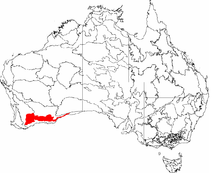Mallee Woodlands and Shrublands
Mallee Woodlands and Shrublands (MVG 14) is a Major Vegetation Group which occurs in semi-arid areas of southern Australia.[1] The vegetation is dominated by mallee eucalypts which are rarely over 6 metres high. Other dominant plant genera are Melaleuca, Acacia and Hakea.[1]
The composition of the understorey depends on factors such as rainfall, soil composition as well as fire frequency and intensity. In subhumid areas, a variety of grasses and shrubs predominate, while in semi-arid areas hummock grasses (Triodia species) predominate.[1]
In 2001, the area covered by this vegetation group was estimated to be 65% of its pre 1788 coverage.[2]
The most extensive extant area of this group in Australia today is found in the Great Victoria Desert. Prior to 1788, the largest area occurred in the Murray-Darling basin.[1]
The Major Vegetation Subgroups for this group are:
- Mallee with hummock grass
- Mallee with a dense shrubby understorey
- Mallee with an open shrubby understorey
- Mallee with a tussock grass understorey.[1]

References
- 1 2 3 4 5 "MVG 14-Mallee Woodlands and Shrublands" (PDF). Australian Natural Resources Atlas. Australian Government. Retrieved 2011-03-08.
- ↑ Lindenmayer, David; Mark Burgman (2005). Practical Conservation Biology (PDF). CSIRO. Retrieved 2009-04-21.
External links
- Environment.gov.au: Mallee Woodlands and Shrublands plant communities — range maps, plant species, images, +conservation.
